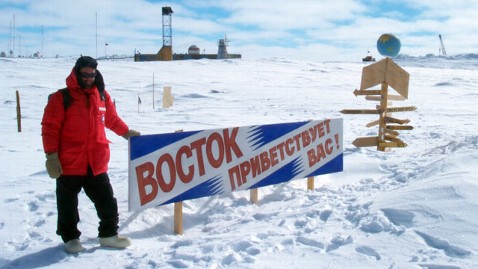Lake Vostok: life beneath the ice

Imagine, Lake Vostok is covered by more than 3,700 metres of Antarctic ice. Devoid of sunlight, it lies far below sea level in a depression that formed 60 million years ago, when the continental plates shifted and cracked. Few nutrients are available. Yet scientist, led by Scott Rogers, a Bowling Green State University professor of biological sciences, have found a surprising variety of life forms living and reproducing in this extreme environment. A paper published June 26 in PLOS ONE details the thousands of species they identified through DNA and RNA sequencing.
What lies sealed beneath the glacial ice?
Antarctica, 35 million years ago, had a temperate climate and was inhabited by a diverse plants and animals. About 34 million years ago, a huge drop in temperature occurred and ice covered the lake, when it was probably still connected to the Southern Ocean. This lowered the sea level by about 100 metres, which could have cut off Lake Vostok from the ocean. The ice cover was intermittent until a second big plunge in temperature took place 14 million years ago, and sea level dropped even farther.
As the ice crept across the lake, it plunged the lake into total darkness and isolated it from the atmosphere, and led to increasing pressure in the lake from the weight of the glacier. While many species probably disappeared from the lake, as indicated by Rogers’ results, some seem to have survived.
Rogers and his colleagues examined core sections from the ice above Lake Vostok that were extracted in 1998. At the time, no one had reached the actual lake, a feat that was achieved only last year. But the drilling had gone deep enough to reach a layer of ice at the bottom of the sheet that formed as lake water froze onto the bottom of the glacier where it meets the lake. The team sampled cores from two areas of the lake, the southern main basin and near an embayment on the southwestern end of the lake. The embayment appears to contain much of the biological activity in the lake.
By sequencing the DNA and RNA from the ice samples, the team identified thousands of bacteria, including some that are commonly found in the digestive systems of fish, crustaceans and annelid worms, in addition to fungi and two species of archaea, or single-celled organisms that tend to live in extreme environments. Other species they identified are associated with habitats of lake or ocean sediments. Psychrophiles, or organisms that live in extreme cold, were found, along with heat-loving thermophiles, which suggests the presence of hydrothermal vents deep in the lake. Rogers said the presence of marine and freshwater species supports the hypothesis that the lake once was connected to the ocean, and that the freshwater was deposited in the lake by the overriding glacier.
These results, however, are not without controversy.
Other claims and other lakes
Long before he began using these techniques to study the ice, Rogers and his team had developed a method to ensure purity. Sections of core ice were immersed in a sodium hypochlorite (bleach) solution, then rinsed three times with sterile water, removing an outer layer. Under strict sterile conditions, the remaining core ice was then melted, filtered and refrozen.
Sergey Bulat has doubts about the results, despite the careful sample preparation. Bulat, a Lake Vostok expert at the Petersburg Nuclear Physics Institute in Gatchina, Russia, is quoted as saying, “that it is very probably that the samples are heavily contaminated with tissue and microbes from the outside world.”
Quirin Schiermeier has noted in Nature News:
Bulat and Rogers have both studied Vostok ice samples taken in the 1990s by a consortium of Russian, French and US Antarctic researchers. In the past, the pair pondered a close collaboration. But their scientific relationship broke over enduring disagreement about the level of contamination of samples.
In March, Bulat himself faced criticism over an unknown species of bacterium his team had discovered in a Lake Vostok ice core drilled last year. Sceptics said that this finding was due to contamination from drilling fluid.
The two researchers’ claims are probably the first in what will no doubt be an interesting period of discovery in Lake Vostok and other Antarctic lakes. The first samples of water from Lake Vostok itself, collected in early 2013 are currently being analysed. The Russian team has said that it hopes to have results within the next year. Bacteria, of known species, have been recovered from the smaller Antarctic Lakes, Whillans and Vida. Lake Vida has been sealed off for around 2,800 years. Ice cores drilled in 2005 and 2010 have recently revealed life, but at about one-tenth of the abundance usually found in freshwater lakes in moderate climate zones. Similarly in Lake Whillans the bacteria levels were roughly one-tenth the abundance of microbes in the oceans.
These results are glimpses into the the sub-glacial world of Antarctica. Glimpses that may change how we not only view this continent but also providing clues to how extra terrestrial life may exist on icy moons such as Jupiter’s Europa and Saturn’s Enceladus.
Orrman-Rossiter K (2013-07-26 00:09:44). Lake Vostok: life beneath the ice. Australian Science. Retrieved: Jul 04, 2025, from http://ozscience.com/science-2/lake-vostok-life-beneath-the-ice/
 Follow
Follow

